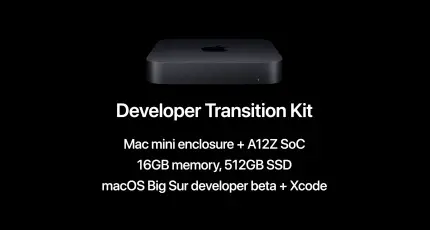Apple
is eager to help developers transition to its forthcoming Apple system-on-a-chip based Mac computers, and it’s preparing a number of resources to do that – including developer hardware. Apple’s Developer Transition Kit, which registered developers can apply for via its developer website, includes a Mac mini with an A12Z processor inside, running a pre-release version of macOS Big Sur.
The kit spec includes 16GB of RAM, as well as a 512GB SSD, and will come with Xcode preinstalled so that developers can get working on their apps right away. This is very much pre-release hardware, however – the first consumer Macs that run on Apple’s in-house silicon won’t ship until later this year, Apple CEO
Tim Cook
said during a keynote event for the company’s Worldwide Developers Conference (WWDC) on Monday.
Apple will also still be selling
Intel
-based Macs, including new ones still in the pipeline, as it transitions to using its own chips, a shift which it expects will take two years to cover the full Mac lineup. But these developer kits will begin shipping out to developers who are approved for the program as early as this week, Cook said – indicating that Apple is very eager to do what it can to get developers on board with the shift.
Applications for the Developer Transition Kit will be available through Apple’s developer.apple.com portal, and you can
apply here to register your interest in taking part
. Unsurprisingly, the application form seems to be suffering under heavy load right now, but check back frequently if you’re really interested in getting your hands on ARM-based Mac hardware early to transition your software.
Apple transitioning its Macs to its own in-house designed processors is a major change, but not one that is new to Apple: In fact, the company moved to new processors twice previously, including switching to PowerPC-based architecture, and then again to Intel chips. In each case, it provided developers with tools including development kits and transitional software layers to enable software designed for previous architectures to work on the new ones.
This promises to potentially be the most significant transition for Mac yet, since it’s a move to silicon designed by Apple. Apple’s A-series chips have led to immense processing speed, power and efficiency gains for iPhones, Macs and Apple Watches over the years, and now the Mac stands ready to benefit in a similar manner.

 简体中文
简体中文

